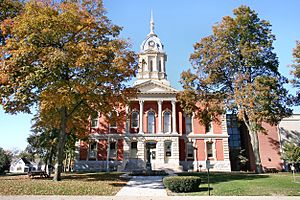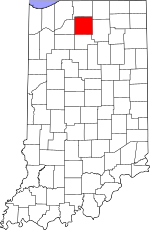Marshall County, Indiana facts for kids
Quick facts for kids
Marshall County
|
|
|---|---|

Marshall County courthouse in Plymouth, Indiana
|
|

Location within the U.S. state of Indiana
|
|
 Indiana's location within the U.S. |
|
| Country | |
| State | |
| Founded | 7 February 1835 (authorized) 1836 (organized) |
| Named for | John Marshall |
| Seat | Plymouth |
| Largest city | Plymouth |
| Area | |
| • Total | 449.74 sq mi (1,164.8 km2) |
| • Land | 443.63 sq mi (1,149.0 km2) |
| • Water | 6.11 sq mi (15.8 km2) 1.36%% |
| Population | |
| • Estimate
(2018)
|
46,248 |
| • Density | 104.2/sq mi (40.2/km2) |
| Time zone | UTC−5 (Eastern) |
| • Summer (DST) | UTC−4 (EDT) |
| Congressional district | 2nd |
| Indiana county number 50 | |
Marshall County is a county in the U.S. state of Indiana. Census 2020 recorded the population at 46,095. The county seat (and only city) is Plymouth.
Contents
History
Marshall County was formed in 1836, during the early years of settlement and before the forced removal of the Potawatomi people in 1838. It was named for U.S. Chief Justice John Marshall, who died in 1835. Marshall County is notable as the starting point in 1838 of the Potawatomi Trail of Death, which was the forced removal by United States forces of Chief Menominee and 859 Potawatomi Indians from Indiana to Indian Territory, at the site of present-day Osawatomie, Kansas, a distance of 660 miles (1,060 km). The first settlers arrived in what is now Marshall County in 1835. They arrived as a result of the end of the Black Hawk War as well as the completion of the Erie Canal. They consisted primarily of settlers from New England, "Yankees" descended from the English Puritans who settled New England in the colonial era. They were mainly members of the Congregational Church, although due to the Second Great Awakening many of them had converted to Methodism and some had become Baptists before coming to what is now Marshall County. As a result of this heritage, some place names in Marshall County are named after places in New England, such as Plymouth, which is named after Plymouth, Massachusetts, the site where the Mayflower landed in 1620. When these settlers arrived, there was nothing but a dense virgin forest and wild marshland, which would need to be cleared and drained before it could be farmed.
Geography
According to the 2010 census, the county has a total area of 449.74 square miles (1,164.8 km2), of which 443.63 square miles (1,149.0 km2) (or 98.64%) is land and 6.11 square miles (15.8 km2) (or 1.36%) is water. The Yellow River flows through northern, central, and western portions of Marshall County, past Plymouth; the Tippecanoe River flows through the southeastern part of the county.
Adjacent counties
- St. Joseph County (north)
- Elkhart County (northeast)
- Kosciusko County (east)
- Fulton County (south)
- Pulaski County (southwest)
- Starke County (west/CST Border)
Major highways
 US 6
US 6 US 30
US 30 US 31
US 31 SR 8
SR 8 SR 10
SR 10 SR 17
SR 17 SR 25
SR 25 SR 106
SR 106 SR 110
SR 110 SR 117
SR 117 SR 331
SR 331
Communities
City
Towns
Census-designated place
- Koontz Lake (partial)
Townships
- Bourbon
- Center
- German
- Green
- North
- Polk
- Tippecanoe
- Union
- Walnut
- West
Climate and weather
| Weather chart for Plymouth, Indiana | |||||||||||||||||||||||||||||||||||||||||||||||
|---|---|---|---|---|---|---|---|---|---|---|---|---|---|---|---|---|---|---|---|---|---|---|---|---|---|---|---|---|---|---|---|---|---|---|---|---|---|---|---|---|---|---|---|---|---|---|---|
| J | F | M | A | M | J | J | A | S | O | N | D | ||||||||||||||||||||||||||||||||||||
|
2.2
32
16
|
1.9
38
20
|
2.9
49
29
|
4
62
39
|
4.3
74
49
|
4.5
83
58
|
3.7
86
62
|
3.4
84
60
|
3.6
77
53
|
3.2
64
42
|
3.2
50
32
|
2.8
37
22
|
||||||||||||||||||||||||||||||||||||
| temperatures in °F precipitation totals in inches source: The Weather Channel |
|||||||||||||||||||||||||||||||||||||||||||||||
|
Metric conversion
|
|||||||||||||||||||||||||||||||||||||||||||||||
In recent years, average temperatures in Plymouth have ranged from a low of 16 °F (−9 °C) in January to a high of 86 °F (30 °C) in July, although a record low of −25 °F (−32 °C) was recorded in January 1985 and a record high of 109 °F (43 °C) was recorded in July 1936. Average monthly precipitation ranged from 1.86 inches (47 mm) in February to 4.48 inches (114 mm) in June.
Demographics
| Historical population | |||
|---|---|---|---|
| Census | Pop. | %± | |
| 1840 | 1,651 | — | |
| 1850 | 5,348 | 223.9% | |
| 1860 | 12,722 | 137.9% | |
| 1870 | 20,211 | 58.9% | |
| 1880 | 23,414 | 15.8% | |
| 1890 | 23,818 | 1.7% | |
| 1900 | 25,119 | 5.5% | |
| 1910 | 24,175 | −3.8% | |
| 1920 | 23,744 | −1.8% | |
| 1930 | 25,077 | 5.6% | |
| 1940 | 25,935 | 3.4% | |
| 1950 | 29,468 | 13.6% | |
| 1960 | 32,443 | 10.1% | |
| 1970 | 34,986 | 7.8% | |
| 1980 | 39,155 | 11.9% | |
| 1990 | 42,182 | 7.7% | |
| 2000 | 45,128 | 7.0% | |
| 2010 | 47,051 | 4.3% | |
| 2018 (est.) | 46,248 | −1.7% | |
| US Decennial Census 1790-1960 1900-1990 1990-2000 2010-2013 |
|||
As of the 2010 United States Census, there were 47,051 people, 17,406 households, and 12,516 families in the county. The population density was 106.1 inhabitants per square mile (41.0/km2). There were 19,845 housing units at an average density of 44.7 per square mile (17.3/km2). The racial makeup of the county was 93.5% white, 0.5% black or African American, 0.5% Asian, 0.2% American Indian, 3.8% from other races, and 1.5% from two or more races. Those of Hispanic or Latino origin made up 8.4% of the population. In terms of ancestry, 35.4% were German, 11.2% were Irish, 9.4% were American, and 8.5% were English.
Of the 17,406 households, 35.2% had children under the age of 18 living with them, 57.2% were married couples living together, 9.9% had a female householder with no husband present, 28.1% were non-families, and 24.1% of all households were made up of individuals. The average household size was 2.66 and the average family size was 3.15. The median age was 38.4 years.
The median income for a household in the county was $47,697 and the median income for a family was $58,017. Males had a median income of $43,732 versus $30,033 for females. The per capita income for the county was $22,493. About 8.7% of families and 12.2% of the population were below the poverty line, including 17.1% of those under age 18 and 10.4% of those age 65 or over.
See also
 In Spanish: Condado de Marshall (Indiana) para niños
In Spanish: Condado de Marshall (Indiana) para niños

